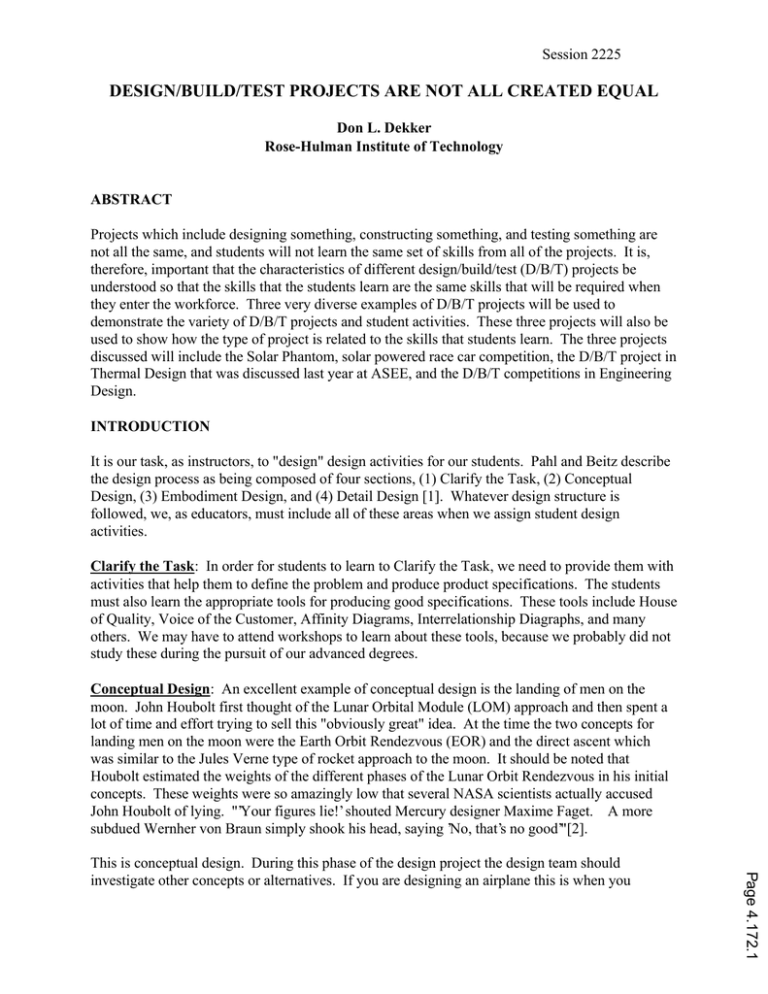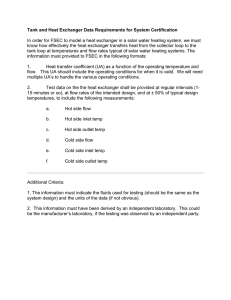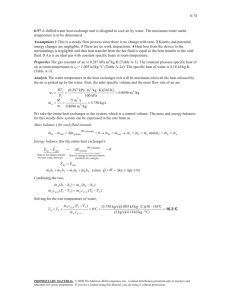Design/Build/Test Projects Are Not All Created Equal
advertisement

Session 2225 DESIGN/BUILD/TEST PROJECTS ARE NOT ALL CREATED EQUAL Don L. Dekker Rose-Hulman Institute of Technology ABSTRACT Projects which include designing something, constructing something, and testing something are not all the same, and students will not learn the same set of skills from all of the projects. It is, therefore, important that the characteristics of different design/build/test (D/B/T) projects be understood so that the skills that the students learn are the same skills that will be required when they enter the workforce. Three very diverse examples of D/B/T projects will be used to demonstrate the variety of D/B/T projects and student activities. These three projects will also be used to show how the type of project is related to the skills that students learn. The three projects discussed will include the Solar Phantom, solar powered race car competition, the D/B/T project in Thermal Design that was discussed last year at ASEE, and the D/B/T competitions in Engineering Design. INTRODUCTION It is our task, as instructors, to "design" design activities for our students. Pahl and Beitz describe the design process as being composed of four sections, (1) Clarify the Task, (2) Conceptual Design, (3) Embodiment Design, and (4) Detail Design [1]. Whatever design structure is followed, we, as educators, must include all of these areas when we assign student design activities. Clarify the Task: In order for students to learn to Clarify the Task, we need to provide them with activities that help them to define the problem and produce product specifications. The students must also learn the appropriate tools for producing good specifications. These tools include House of Quality, Voice of the Customer, Affinity Diagrams, Interrelationship Diagraphs, and many others. We may have to attend workshops to learn about these tools, because we probably did not study these during the pursuit of our advanced degrees. Conceptual Design: An excellent example of conceptual design is the landing of men on the moon. John Houbolt first thought of the Lunar Orbital Module (LOM) approach and then spent a lot of time and effort trying to sell this "obviously great" idea. At the time the two concepts for landing men on the moon were the Earth Orbit Rendezvous (EOR) and the direct ascent which was similar to the Jules Verne type of rocket approach to the moon. It should be noted that Houbolt estimated the weights of the different phases of the Lunar Orbit Rendezvous in his initial concepts. These weights were so amazingly low that several NASA scientists actually accused John Houbolt of lying. "’Your figures lie!’ shouted Mercury designer Maxime Faget. A more subdued Wernher von Braun simply shook his head, saying ’No, that’s no good’"[2]. Page 4.172.1 This is conceptual design. During this phase of the design project the design team should investigate other concepts or alternatives. If you are designing an airplane this is when you would investigate different wing shapes and configurations. This phase of the design process doesn’t take a lot of time, but an inappropriate selection here can cause insurmountable problems later. Since this "conceptual design" phase doesn’t take a lot of time and it is not very rigorous, students often consider this phase unimportant. Students want to get into the real "nitty-gritty" and utilize the wonderful analytic skills that they have struggled so hard to master. However, one can only analyze something after it has been conceived. Embodiment Design: Embodiment design is usually done in colleges because this is where the students can decide on the configuration and then utilize their analysis tools to make the engineering and economic decisions that will lead to a workable configuration. Detail Design: When it comes to the detail design phase of the design processes, colleges and universities are unable to do very much because of the wide range of the detail design phase. We decide that we want our students to experience a "design-build-test" project so they will learn more about the entire product realization process. Then we have to think more about the components of the particular project, and the aspects of design that we want the students to be exposed to and therefore learn. Three very different "design-build-test" projects are discussed. The first is a heat exchanger project in ME 462, Thermal Design. This was discussed in more detail at the 1998 ASEE meeting.[3] The second type of project is the project used last quarter in ME 450, Engineering Design, which was a vehicle powered by an unopened soft drink can. The third project is the Solar Powered Vehicle. At Rose-Hulman this is the Solar Phantom team and is not associated with any particular class. THERMAL DESIGN: HEAT EXCHANGER PROJECT Heat Exchanger Design: The students design their heat exchanger during the first three weeks of the quarter. Examples of several different heat exchangers and different configurations are shown to the students during the first class period so they will be able to discuss alternative possible designs. The heat exchanger design for the prototype is supported by lectures. The students must estimate the film coefficients for cold water, hot water, and Paratherm, calculate the overall heat transfer coefficient, and estimate the size of the heat exchanger. They must perform the calculations for at least two different configurations. Each group must purchase the parts for its design. Having the student groups purchase the parts of their design provides a very real economic incentive to keep the cost low. In addition to the Design report, they must write construction instructions and testing instructions. The Design report contains their design calculations and the supporting evidence for their design. Page 4.172.2 Construction: The construction instructions and materials for construction are passed to another group, which builds the heat exchanger. This technique forces the design group to finalize their design and to stop making design changes. It has been my experience that when this transfer of responsibility does not take place, the design group never stops "designing" and "fiddling around" with their design. If the construction group has any problems, they have to contact the design group and settle the differences. This provides the opportunity for meaningful communications to take place and it doesn’t go through the instructor. The construction phase takes one week, although most groups are able to perform the required construction tasks in 2 to 4 hours. Testing: The device is then passed to a third group for testing. Although the heat exchanger is designed to be used with a heat transfer fluid as the hot fluid of about 600 degrees Fahrenheit, it is tested with hot water for safety and economic reasons. The testing takes place in a laboratory on a testing setup for testing student heat exchangers. It takes a group only about 30 minutes to test a heat exchanger, if it works well. One of the problems that is often encountered is leakage. Final Report: The design group is then responsible for presenting and writing a comprehensive report which describes their design for a "real" heat exchanger which is to be used in the plant. This redesign portion is very important because it simulates the entire product realization process. This report also includes a comparison of the film coefficients which are obtained from the test results to the values of the film coefficients they used to design and size the heat exchanger. The final report also includes documenting the design changes, any construction difficulties, and describing the original design of their heat exchanger along with the several alternatives, which were considered. CAN POWERED VEHICLE Several of the pertinent rules for the 1998 project in ME 450, Engineering Design are given below. "The object of this project is to design, analyze, construct and demonstrate a "device" which will move an unopened 12 ounce beverage can from the South out-of-bounds line of one of the SRC basketball courts to inside the red center jump circle of the same court in the minimum time possible. The only energy source for performing this task shall consist of the potential energy of the can." Rules: 2) The entire device must lie behind the starting line at the start of the test. 4) The entire device must lie in front of the starting line at the end of the test. 5) The can must come to rest inside the red center circle and must touch the floor Evaluation: 15 S = ------- (90) + 30 (Maximum value of S = 120) (D+1) Where: D = distance (in feet) of the can at the end of the test from the red circle t = elapsed time (in seconds) from start to finish of test This problem definition allowed the students to be very creative and they produced a wide variety of designs. In this type of competition the student groups never really end the design phase. They design, construct, try, redesign, change, try until the competition. Although some groups spend the entire night before the competition constructing their device, other groups had their device built and tested days ahead of time. Many students appreciate the chance to exercise their creativity. Page 4.172.3 Some of the different "devices" are shown in Figures 1, 2, 3, & 4 Figure 1: Short Tower Vehicle Figure 2: Tall Tower Vehicle Figure 3: Rolling Cart Version Figure 4: “Rube Goldberg” Version Page 4.172.4 SOLAR PHANTHOM The Solar Phantom team is a student activity that is done outside the classroom. The problem is clearly defined as far as the goal, but there are many different designs and configurations that can possibly win the competition. The last competition was a nine day drive from Indianapolis, Indiana to Golden, Colorado. The competition is similar to the Tour de France. The cars all drove the same number of miles every day and then recharged batteries in the remaining sunlight, and rested at the same place. In addition to the usual aspects of the design process, the Solar Phantom team also has to find supporters who will donate either time, materials, expertise, or money. These additional tasks require an organization which will make sure that all of the required tasks are completed. The officers of the organization are CEO, Financial, Secretary, Head of Mechanical, Head of Electrical, and Publicity. The publicity has two purposes. One is educational and the students make presentations to different schools and to the public. The other purpose is make presentations to sponsors and potential sponsors. This organization provides leadership training to several of the participants that is not present in the other D/B/T projects. Once the first car was built, additional cars were more of a refinement and redesign than a new conceptual design. The embodiment design is a large task for the students and the detail design is extremely important because if it doesn’t work, you don’t do very well in the competition. COMPARISON These three projects and what phases of the product realization process each one emphasizes, can be seen in the following table, Figure 5. The four phases of design are listed along the left side along with construction, testing, redesign, creativity, and leadership. A "typical" industrially sponsored project is listed at the top of the table along with the three projects discussed here. Clarify the Task Conceptual Design Embodiment Design Detail Design Construction Testing Re-Design Creativity Leadership Heat Exchanger Not Much Can-Powered Vehicle Not Much Solar Powered Vehicle Not Much Yes Yes-A LOT! Not Much "Typical" Industrially Sponsored Project MaybeMaybe Not Yes Yes Yes Yes Yes Yes Yes Yes-A LOT! Yes Yes Yes Yes Yes No Some Some A LOT! No Yes-A LOT1 Yes Yes (for the next competition) No Yes Usually Not Much None to Some None None Maybe No/Maybe Figure 5: Matrix Showing How Each of the Projects Emphasizes Different Skills. Page 4.172.5 CONCLUSION The three projects which were discussed here are all design, build, test projects, but they do not all emphasize the same skills and utilize the same abilities. Therefore when we, as instructors, plan design activities for the students, it is imperative that the student activities correspond to the skills that are important to develop. BIBLIOGRAPHY [1] Pahl, G. and Beitz, W., Engineering Design: A Systematic Approach, Edited by Ken Wallace, Springer-Verlag, The Design Council, 1988 [2] Mason, Robert, G., Editor, LIFE IN SPACE, Time-Life Books, Little, Brown and Company, Boston, 1983 [3] Dekker, Don L., "Design, Build, Test Project in Thermal Design", 1998 ASEE Annual Conference, Seattle, BIOGRAPHICAL INFORMATION Don Dekker, Professor of Mechanical Engineering, teaches Thermal Design, Internal Combustion Engines, Kinematics, M. E. Laboratory, and Fundamentals of Engineering Management. He has been active in ASEE and was Zone II Chairman and Chairman of the Design in Engineering Education Division. His Ph.D. is from Stanford(1973), his Masters from the University of New Mexico(1963) and he earned his Bachelors from Rose Polytechnic Institute(1961). Page 4.172.6



